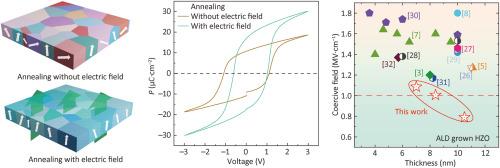Reduced coercive field and enhanced ferroelectric polarization of Hf0.5Zr0.5O2 film through electric-field-assisted rapid annealing
IF 9.6
1区 材料科学
Q1 CHEMISTRY, PHYSICAL
引用次数: 0
Abstract
Hafnium oxide–based ferroelectric materials emerged as promising candidates for constructing next-generation high-density memory devices due to their silicon compatibility. However, the high coercive field (Ec, typically exceeding 1.0 MV/cm) puts forward challenges to high operating voltage and limited endurance performance. To overcome these limitations, a strategy is utilized by applying an in-situ direct current electric field during rapid thermal process (RTP). This approach enables simultaneous reduction of coercive field and enhancement of ferroelectric polarization in Hf0.5Zr0.5O2 (HZO). Notably, a record-low Ec (∼0.79 MV/cm) is achieved among atomic layer deposition-grown Zr-doped HfO2 ferroelectric films, facilitating lower operation voltage, faster switching speed, and improved endurance characteristics. High-resolution transmission electron microscopy analysis reveals that the ferroelectric domains in samples through electric field assisted-RTP exhibit a relatively preferential out-of-plane orientation compared to normal RTP-treated samples, which is the underlying mechanism in reducing the coercive field and enhancing ferroelectric polarization. This study introduces a practical and effective method for optimizing the overall performance of HZO films, underscoring their potential for application in non-volatile memory technologies.


电场辅助快速退火使Hf0.5Zr0.5O2薄膜的矫顽力场减小,铁电极化增强
基于氧化铪的铁电材料由于其硅兼容性而成为构建下一代高密度存储器件的有希望的候选者。然而,高矫顽力场(Ec,通常超过1.0 MV/cm)对高工作电压和有限的持久性能提出了挑战。为了克服这些限制,采用了在快速热过程(RTP)中施加原位直流电场的策略。该方法可以使Hf0.5Zr0.5O2 (HZO)中矫顽力场的减小和铁电极化的增强同时发生。值得注意的是,在原子层沉积生长的掺杂zr的HfO2铁电薄膜中,实现了创纪录的低Ec (~ 0.79 MV/cm),促进了更低的工作电压,更快的开关速度和改进的续航特性。高分辨率透射电镜分析表明,电场辅助rtp处理后样品的铁电畴相对于普通rtp处理样品表现出相对优先的面外取向,这是降低矫顽力场和增强铁电极化的潜在机制。本研究介绍了一种实用有效的方法来优化HZO薄膜的整体性能,强调了它们在非易失性存储技术中的应用潜力。
本文章由计算机程序翻译,如有差异,请以英文原文为准。
求助全文
约1分钟内获得全文
求助全文
来源期刊

Journal of Materiomics
Materials Science-Metals and Alloys
CiteScore
14.30
自引率
6.40%
发文量
331
审稿时长
37 days
期刊介绍:
The Journal of Materiomics is a peer-reviewed open-access journal that aims to serve as a forum for the continuous dissemination of research within the field of materials science. It particularly emphasizes systematic studies on the relationships between composition, processing, structure, property, and performance of advanced materials. The journal is supported by the Chinese Ceramic Society and is indexed in SCIE and Scopus. It is commonly referred to as J Materiomics.
 求助内容:
求助内容: 应助结果提醒方式:
应助结果提醒方式:


